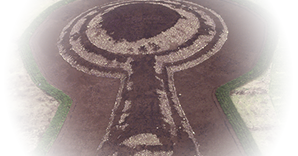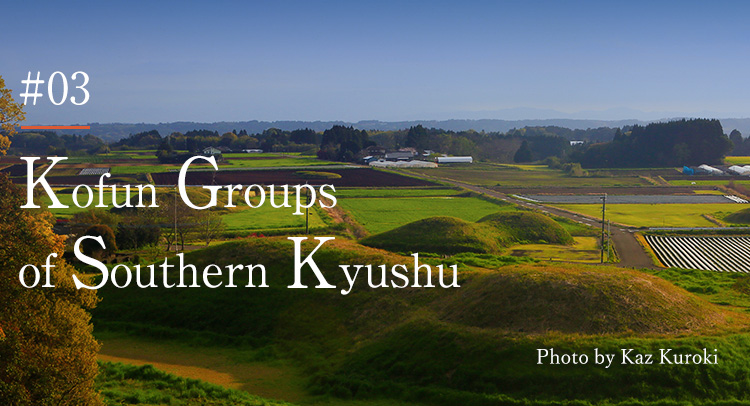Photo by Kaz Kuroki
Keyhole-shaped burial mounds
前方後円墳

前方後円墳
Keyhole-shaped burial mounds first appeared in the latter half of the 3rd century mainly in the Kinki and Setonai regions, and became distributed from southern Tohoku (present day Miyagi Prefecture) to southern Kyushu (present day Kagoshima Prefecture).
170 keyhole-shaped burial mounds have been confirmed in Miyazaki Prefecture. However, keyhole-shaped burial mounds are not found in all areas of the prefecture; rather, they are concentrated mainly in coastal areas facing the Sea of Hyuga, and inland are limited only to the north of the Miyakonojo Basin. Keyhole-shaped burial mounds are distributed among the current municipalities of Nobeoka City, Hyuga City, Kawaminami Town, Takanabe Town, Shintomi Town, Miyazaki City, Kunitomi Town, Nichinan City, Kushima City, and Miyakonojo City.
The largest keyhole-shaped burial mounds include Saitobaru Mound No. 81 (Saitobaru City), Shimoyashiki Kofun (Shintomi Town), and Aoki Mound No. 1 (Miyazaki City). Evidence suggests that construction commenced mainly in plain areas of Miyazaki at the end of the 3rd century/beginning of the 4th century (Early Kofun period). From the middle of the 4th century to the beginning of the 4th century (latter half of the Early Kofun period), a form of keyhole-shaped burial mound unique to southern Kyushu emerged in major kofun groups in plain areas of Miyazaki, such as Ikime, Saitobaru, Mochida and Kawaminami, as well as the Osumi region. Known as “ekagamigata (hand mirror-shaped) keyhole-shaped burial mounds,” kofun of this type feature an elongated frontal section with a planar form shaped like a hand mirror.

Keyhole-shaped Burial Mounds(Saitobaru Mound No.100)
During the first half of the 5th century (first half of the Middle Kofun period), colossal keyhole-shaped burial mounds were constructed mainly in the former provinces of Kawachi and Izumi, such as Mozu and Furuichi kofun groups (Osaka Prefecture). One of the most famous of these is Daisen Kofun (attributed to Emperor Nintoku), the largest burial mound in Japan with a length of 486 m. Huge kofun of this kind were also constructed in Miyazaki Prefecture during this period, suggesting connections with trends taking place elsewhere on the Japanese archipelago: Osahozuka, the largest scallop-shaped burial mound in Japan (mound length: 176 m), and Mesahozuka, the largest keyhole-shaped burial mound in Kyushu (mound length: 176 m), both of which form part of Saitobaru Kofun Group.
A number of colossal kofun were constructed in Kyushu, but of the 12 large kofun exceeding 120 m in length in Kyushu, 6 are located in Miyazaki Prefecture, as follows: Sugawara Jinja Kofun (Nobeoka City: 120 m), Mochida Mound No. 1 (Takanabe City: 120 m), Osahozuka (Saitobaru City: 176 m), Mesahozuka (Saitobaru City: 176 m), Ikime Mound No. 1 (Miyazaki City: 130 m), and Ikime Mound No. 3 (Miyazaki City: 137 m).




